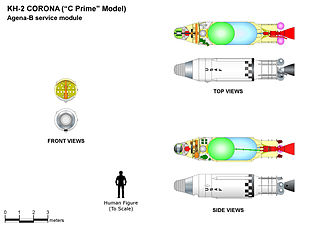
The RM-81 Agena was an American rocket upper stage and satellite bus which was developed by Lockheed Corporation initially for the canceled WS-117L reconnaissance satellite program. Following the split-up of WS-117L into SAMOS and Corona for image intelligence, and MIDAS for early warning, the Agena was later used as an upper stage, and an integrated component, for several programs, including Corona reconnaissance satellites and the Agena Target Vehicle used to demonstrate rendezvous and docking during Project Gemini. It was used as an upper stage on the Atlas, Thor, Thorad and Titan IIIB rockets, and considered for others including the Space Shuttle and Atlas V. A total of 365 Agena rockets were launched between February 28, 1959 and February 1987. Only 33 Agenas carried NASA payloads and the vast majority were for DoD programs.

Thor-Agena was a series of orbital launch vehicles. The launch vehicles used the Douglas-built Thor first stage and the Lockheed-built Agena second stages. They are thus cousins of the more-famous Thor-Deltas, which founded the Delta rocket family. The first attempted launch of a Thor-Agena was in January 1959. The first successful launch was on 28 February 1959, launching Discoverer 1. It was the first two-stage launch vehicle to place a satellite into orbit.

Thor was a US space launch vehicle derived from the PGM-17 Thor intermediate-range ballistic missile. The Thor rocket was the first member of the Delta rocket family of space launch vehicles. The last launch of a direct derivative of the Thor missile occurred in 2018 as the first stage of the final Delta II.

Discoverer 14, also known as Corona 9009, was a spy satellite used in the Corona program managed by Advanced Research Projects Agency (ARPA) of the Department of Defense and the United States Air Force. On 19 August 1960, usable photographic film images of the Soviet Union taken by the satellite were recovered by a C-119 recovery aircraft. This was the first successful recovery of film from an orbiting satellite and the first mid-air recovery of an object returning from Earth orbit.

The Thor-Ablestar, or Thor-Able-Star, also known as Thor-Epsilon was an early American expendable launch system consisting of a PGM-17 Thor missile, with an Ablestar upper stage. It was a member of the Thor family of rockets, and was derived from the Thor-Able.

The Delta 1000 series was an American expendable launch system which was used to conduct eight orbital launches between 1972 and 1975. It was a member of the Delta family of rockets. Several variants existed, differentiated by a four digit numerical code. Delta 1000 was developed by McDonnell Douglas company in 1972.

Discoverer 11, also known as Corona 9008, was an American optical reconnaissance satellite launched on 15 Apr 1960 at 20:30:37 GMT. The eighth of ten operational flights of the Corona KH-1 spy satellite series, it successfully employed the first space-worthy camera film; however, Discoverer's film return capsule was lost during reentry on 16 Apr when the satellite's spin motors exploded.
Discoverer 24, also known as Corona 9018A, was an American area survey optical reconnaissance satellite which was launched in 1961 but failed to achieve orbit. It was a KH-5 Argon satellite, based on an Agena-B. It was the third KH-5 to be launched.

Discoverer 16, also known as Corona 9011, was an American optical reconnaissance satellite which was lost in a launch failure on 26 October 1960. It was the first of ten Corona KH-2 satellites, based on the Agena-B.
Discoverer 19, also known as RM-1, was an American satellite which was launched in 1960. It was a technology demonstration spacecraft, based on an Agena-B.

Discoverer 4, also known as Corona 9001, was an American optical reconnaissance satellite launched on 25 Jun 1959 at 22:47:45 GMT, the first of ten operational flights of the Corona KH-1 spy satellite series, and the first satellite to be equipped for photo surveillance. The satellite was not successfully orbited. Its loss spurred improvements of its rocket booster to ensure the success of subsequent missions.

Discoverer 9, also known as Corona 9006, was an American optical reconnaissance satellite launched on 4 Feb 1960 at 18:51:45 GMT, the sixth of ten operational flights of the Corona KH-1 spy satellite series, and the first of them to be equipped with a new, vacuum-proof, polyester-based film. The satellite was not successfully orbited.

Discoverer 10, also known as Corona 9007, was an American optical reconnaissance satellite launched on 19 Feb 1960 at 20:15:14 GMT, the seventh of ten operational flights of the Corona KH-1 spy satellite series,

Discoverer 12 was an American optical reconnaissance satellite launched on 29 Jun 1960 at 22:00:44 GMT. The fourth of five test flights of the Corona KH-1 spy satellite series, it was lost when the second stage failed during launch.

Discoverer 15, also known as Corona 9010, was a spy satellite used in the Corona program managed by Advanced Research Projects Agency (ARPA) of the Department of Defense and the United States Air Force. Launched on 13 September 1960, the satellite took reconnaissance photos of the Soviet Union. However, its recoverable film capsule was lost in the Pacific Ocean after reentry outside the recovery zone on 15 September.







